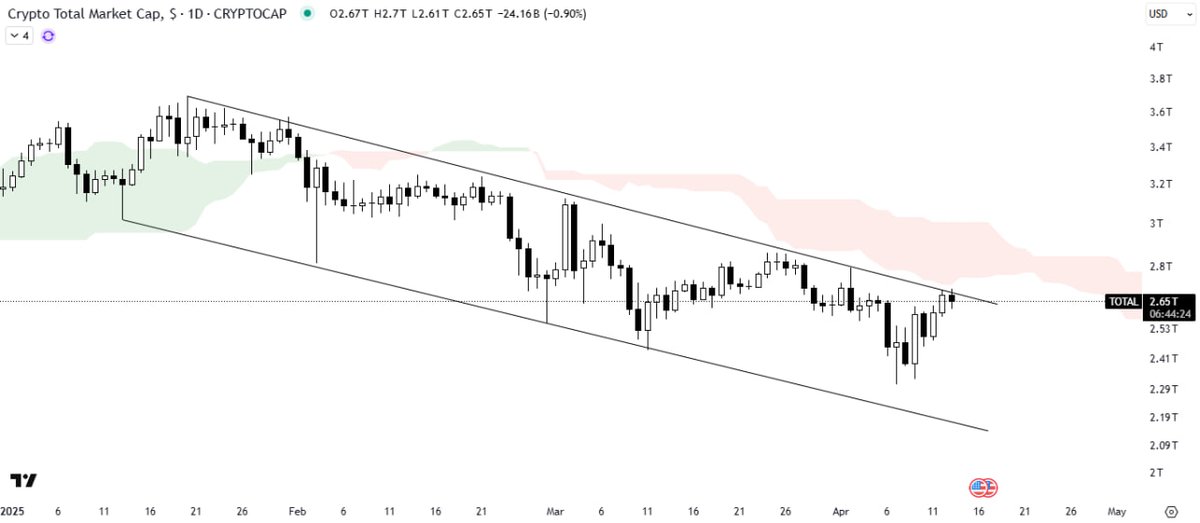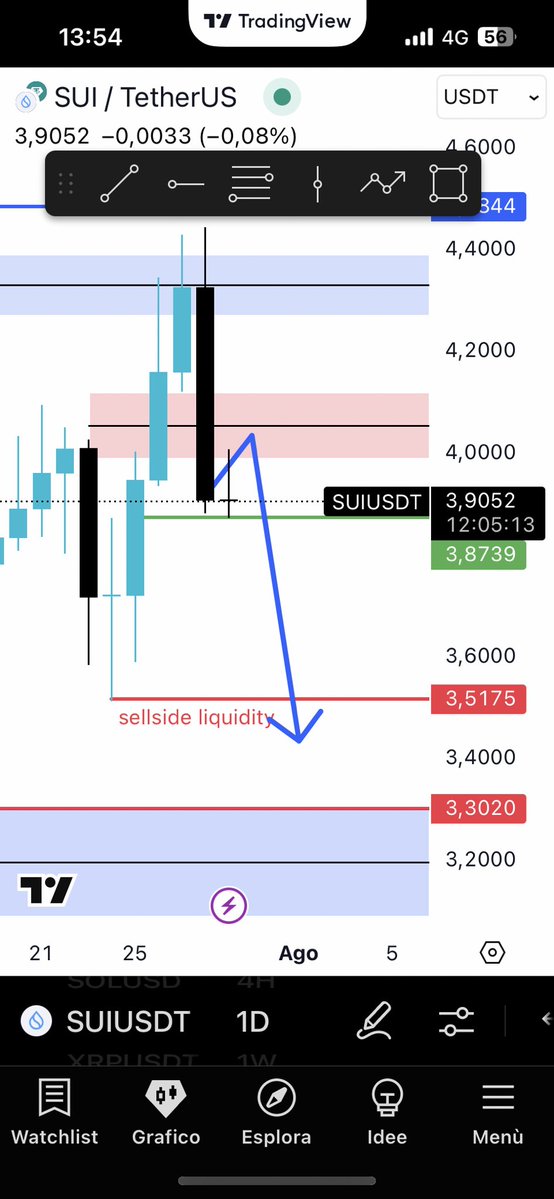The Current Landscape
Imagine the cryptocurrency market as a vast ocean, where the total market cap is a ship navigating through unpredictable waters. As of April 13, 2025, this ship finds itself in a descending channel, a pattern that has been a significant topic of discussion among analysts and traders alike. The market cap is currently facing rejection from the resistance trendline of this channel, with the Ichimoku Cloud acting as a formidable barrier above[1][2][4].
The cryptocurrency market is known for its volatility and unpredictability. The current situation, where the market cap is stuck in a descending channel, is a classic example of this. To understand the implications, let’s delve deeper into the technical aspects and market sentiment.
Understanding the Descending Channel
A descending channel is a technical analysis pattern that indicates a bearish trend. It is characterized by a downward slope with parallel support and resistance lines. In this scenario, the market cap is bouncing between these lines, unable to break through the resistance. The Ichimoku Cloud, a comprehensive indicator that provides insights into trend direction, momentum, and support/resistance levels, is adding to the complexity by acting as an additional resistance barrier[5].
The Role of the Ichimoku Cloud
The Ichimoku Cloud is a versatile indicator that can help traders identify trends, support, and resistance levels. In this case, it is acting as a strong resistance barrier, making it difficult for the market cap to break through. The cloud is composed of several lines, including the Conversion Line, Base Line, Leading Span A, and Leading Span B. The space between these lines forms the cloud, which can indicate future support and resistance levels[5].
The Ichimoku Cloud’s role in this scenario is crucial. It provides a visual representation of potential future price movements, helping traders make more informed decisions. The cloud’s resistance level is a significant barrier, and breaking through it would be a strong bullish signal.
Market Sentiment and Trading Strategies
Given the current market conditions, traders are adopting various strategies to navigate the descending channel. Some are using stop-loss orders to prevent significant losses, while others are looking for opportunities to short the market. The sentiment among traders is mixed, with some remaining optimistic about a potential breakout, while others are preparing for further declines[3].
The Importance of Stop-Loss Orders
Stop-loss orders are crucial in a volatile market like cryptocurrency. They allow traders to limit their losses by automatically selling an asset when it reaches a certain price. In the current market, where the total cap is facing strong resistance, stop-loss orders can help traders avoid significant losses in case of a further decline[3].
Potential Breakout Scenarios
Despite the bearish trend, there is always a possibility of a breakout. If the market cap manages to close above the resistance trendline, it could signal a reversal of the bearish trend. This would be a bullish sign, indicating that the market is ready for a rally. However, until this happens, traders should remain cautious and prepared for both scenarios[6].
The Impact on Individual Cryptocurrencies
The descending channel and the Ichimoku Cloud’s resistance are not just affecting the total market cap but also individual cryptocurrencies. For instance, $OM is facing a critical support level, with analysts warning of a potential 50% crash if it fails to hold[3]. Similarly, other cryptocurrencies are also feeling the pressure, with some analysts issuing sell signals for assets like Ethereum and Bitcoin[7][8].
The Case of $OM
$OM is currently at a critical juncture, with its last line of defense before a potential 50% crash. Previous analyses have shown that the cryptocurrency can be highly volatile, with significant price swings in short periods. Traders are advised to be cautious and consider using stop-loss orders to manage potential losses[3].
Looking Ahead
The cryptocurrency market is known for its volatility and unpredictability. While the current descending channel and the Ichimoku Cloud’s resistance present challenges, they also offer opportunities for traders who can navigate them effectively. It is essential to stay informed, use appropriate trading strategies, and remain prepared for both bullish and bearish scenarios.
The Need for Continuous Learning
The cryptocurrency market is constantly evolving, with new trends, patterns, and indicators emerging regularly. Therefore, it is crucial for traders to stay updated and continuously learn. This includes understanding technical analysis, market sentiment, and the impact of global events on the market.
The Role of Community and Collaboration
The cryptocurrency community plays a significant role in shaping the market. Platforms like Twitter, Reddit, and Telegram are hubs for discussions, analyses, and collaborations. Engaging with the community can provide valuable insights and help traders make more informed decisions[9].
Embracing the Unpredictability
The cryptocurrency market is a rollercoaster ride, with its share of ups and downs. The current descending channel and the Ichimoku Cloud’s resistance are just another chapter in this ongoing story. As traders, it is essential to embrace the unpredictability, stay informed, and be prepared for all scenarios. After all, every challenge presents an opportunity for growth and learning.
—
[1]: Binance Futures Signals. (2025, April 13). #TOTAL MARKET CAP ANALYSIS. Twitter
[2]: Bitget Free Crypto Signals. (2025, April 13). #TOTAL MARKET CAP ANALYSIS. Twitter
[3]: NakedTrader. (2025, April 13). $OM last line of defense. Twitter
[4]: CryptOpus. (2025, April 13). #TOTAL MARKET CAP ANALYSIS. Twitter
[5]: Investopedia. (2023). Ichimoku Cloud: A Comprehensive Guide. Investopedia
[6]: GFE CRYPTO. (2025, April 13). UPDATE: $TOTAL. Twitter
[7]: TACrypto. (2025, April 13). #ethereum > SELL Signal. Twitter
[8]: TACrypto. (2025, April 13). #bitcoin > SELL Signal. Twitter
[9]: Donwise Marketing King. (2025, April 13). Market Analysis from April 5 to April 12. Twitter





